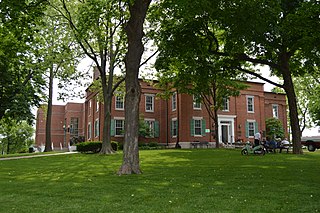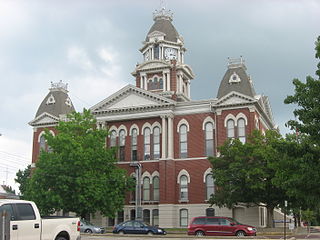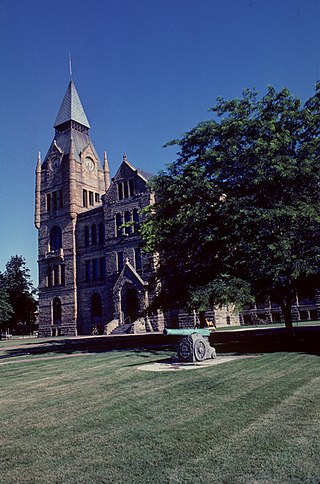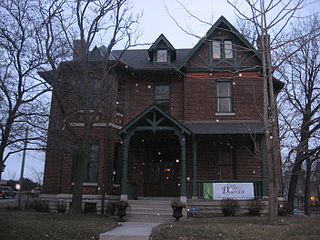
Belleville is a city and the county seat of St. Clair County, Illinois, United States. It is located within Greater St. Louis. The population was 42,404 at the 2020 census, making it the most-populated city in Southern Illinois and in the Metro East region of Greater St. Louis. Due to its proximity to Scott Air Force Base, the population receives a boost from military and federal civilian personnel, defense contractors, and military retirees. It is also the seat of the Roman Catholic Diocese of Belleville and the National Shrine of Our Lady of the Snows.

Chatham is one of the 77 community areas of the city of Chicago, Illinois. It is located on the city's South Side. It includes the neighborhoods of Chatham-Avalon, Chatham Club, Chesterfield, East Chatham, West Chatham and the northern portion of West Chesterfield. Its residents are predominantly African American, and it is home to former Senator Roland Burris. Housing many city employees and other officials, Chatham has been a central area for Chicago's middle-class African Americans since the late 1950s.

The Sycamore Historic District is a meandering area encompassing 99 acres (400,000 m2) of the land in and around the downtown of the DeKalb County, Illinois county seat, Sycamore. The area includes historic buildings and a number of historical and Victorian homes. Some significant structures are among those located within the Historic District including the DeKalb County Courthouse and the Sycamore Public Library. The district has been listed on the National Register of Historic Places since May 2, 1978.

The East Grove Street District is a residential historic district located on the 400 through 700 blocks of East Grove Street in Bloomington, Illinois. The district includes 43 houses and apartment buildings, 25 of which are considered contributing buildings. The houses in the district were built between 1855 and 1915 for many of Bloomington's upper middle class residents. Due to a building boom between 1880 and 1900, the then-popular Queen Anne style is the most prevalent in the district. Other popular architectural styles in the district include Greek Revival homes from the 1850s, Italianate homes built between 1860 and 1880, and Arts and Crafts homes built in the 1900s.

Barry Historic District is a historic district comprising the commercial and older residential areas of Barry, Pike County, Illinois. Barry was founded as an agricultural community in the 1830s, and most of its development took place between its founding and the Civil War. The city's commercial core, however, was mainly built in 1894 after a fire destroyed most of the existing commercial buildings. The 1894 buildings are well-preserved examples of typical commercial architecture of the period, and several have metal storefronts. The district also includes Barry's "Diamond Hill" residential district on Mortimer Street east of Brown Street and several other residential sections. Prominent architectural styles in the residential areas include Italianate, Queen Anne, Carpenter Gothic, and vernacular types from the late 19th century.

The Frank Lloyd Wright/Prairie School of Architecture Historic District is a residential neighborhood in the Cook County, Illinois village of Oak Park, United States. The Frank Lloyd Wright Historic District is both a federally designated historic district listed on the U.S. National Register of Historic Places and a local historic district within the village of Oak Park. The districts have differing boundaries and contributing properties, over 20 of which were designed by Frank Lloyd Wright, widely regarded as the greatest American architect.

The Peter A. Beachy House is a home in the Chicago suburb of Oak Park, Illinois that was entirely remodeled by architect Frank Lloyd Wright in 1906. The house that stands today is almost entirely different from the site's original home, a Gothic cottage. The home is listed as a contributing property to the Frank Lloyd Wright-Prairie School of Architecture Historic District, which was listed on the U.S. National Register of Historic Places.

The Waterloo Historic District is a historic district composed of the majority of central Waterloo, Illinois. The district includes 271 buildings, of which 182 are contributing buildings to its historic character. The center of the district includes Waterloo's town square, the site of the Monroe County Courthouse, as well as a two-block section of Main Street which forms the city's commercial core. The town square is surrounded by residential development on three sides, an unusual arrangement among small towns in Illinois. The predominant architectural styles in the residential parts of the district are local adaptations of the Federal style and a German cottage style developed by the city's German immigrants in the 19th century.

The East End Historic District encompasses a large 19th-century residential area in eastern Galveston, Texas. The area is roughly bounded by Broadway to the south, Market St to the north, 19th St to the west, and 9th street to the east. The area has one of the best-preserved and largest concentrations of 19th-century residential architecture in Texas. It was developed mainly at a time when Galveston was the state's preeminent port. The historic district, designated locally in 1970, was placed on the National Register of Historic Places in 1975 and declared a National Historic Landmark in 1976.

The Saxonburg Historic District is a national historic district that is located in Saxonburg, Butler County, Pennsylvania.

Heathsville Historic District is a national historic district located at Heathsville, Northumberland County, Virginia. The district includes 81 contributing buildings, 12 contributing sites, 4 contributing structures, and 4 contributing objects in the county seat of Northumberland County. It is an assemblage of residential, commercial, and government buildings dating from the 18th through 20th centuries in a variety of popular architectural styles. The linear district is centered on the courthouse square. Notable buildings include the Northumberland Court House, the old county jail (1844), the former Methodist Protestant Church, Harding House, Belleville, Heathsville Masonic Lodge No. 109 (1894), Bank of Northumberland (1924), and the Heathsville United Methodist Church (1894). Located in the district and separately listed are Rice's Hotel, Oakley, St. Stephen's Church, Sunnyside, and The Academy.

The Red Bud Historic District is a commercial and residential historic district which includes the originally developed portions of Red Bud, Illinois, United States. The district is centered on Main and Market Streets, the primary roads through the city. One hundred and ninety-five buildings and structures, including 138 contributing buildings, are included in the district. The oldest building in the district, the Greek Revival Durfee and Crozier Store, dates from 1855, seven years after Red Bud was platted. The community rapidly developed between the 1850s and 1880s, and architectural styles from these decades are prominently represented in the district. The Federal and Italianate styles are the two most prevalent in the district, the latter being an especially popular commercial design. Gothic Revival churches, Second Empire buildings, and a number of German-style cottages can also be found in the district. Development and population growth in Red Bud remained stable in Red Bud from the 1890s through most of the 20th century, and the historically developed core makes up most of the modern city.

The Pennsylvania Avenue Historic District is a residential historic district located on the 1000 block of Pennsylvania Avenue in East St. Louis, Illinois. The district includes four houses as well as the sites of two demolished homes. The historic district was once a prestigious area of the city known as "Quality Hill", and it contained well-built homes designed in popular architectural styles. However, East St. Louis entered a severe decline due to the loss of its industry, racial discrimination, and a corrupt and mismanaged city government. The historic district suffered the same fate as the city; the district is marked by vacant lots and abandoned buildings, and all but one of the houses had been vacated or demolished by the 1970s.

The St. Louis Street Historic District is a residential historic district located along several blocks of St. Louis Street in Edwardsville, Illinois. The district includes 59 homes, of which 51 are considered contributing to the district's historic character. St. Louis Street was one of the most prestigious sections of Edwardsville in the late 1800s, and several of the city's wealthiest residents owned homes along the street. The first house on the street, a log cabin, was built by John Lusk in 1809. In the 1870s, prominent residents of Edwardsville began building homes on the south side of St. Louis Street; these houses typically had large plots and open parkland between lots. In 1883, Judge Joseph Gillespie divided and sold the land on the north side of the street; the homes built on these lots are consequently much closer together. The homes built in the district were designed in popular architectural styles of the late 1800s; while the Queen Anne style is the most prevalent, Italianate, Chateauesque, and Classical Revival houses were also built.

The Shelbyville Historic District is a historic district encompassing the core of Shelbyville, Illinois. The district includes 398 buildings, 293 of which are contributing buildings. The section of Shelbyville laid out at the city's founding in 1827 forms the center of the district. Shelbyville's public square, which includes the 1880 Shelby County Courthouse and a veterans' memorial, is the central feature of this part of the historic district. The original section of Shelbyville also includes significant commercial and government buildings. The district also includes Shelbyville's oldest residential areas, which developed out from the 1827 core. The Italianate style is the most prominent architectural style in the district, both in homes and commercial buildings; other common architectural styles include Greek Revival, Gothic Revival, Second Empire, and Queen Anne.

The Logan Square Boulevards Historic District is a linear historic district in the Logan Square community area of North Side, Chicago. It encompasses 2.5 miles (4.0 km) of the Chicago boulevard system.

The Galesburg Historic District is a 496-acre (201 ha) historic district in Galesburg, Illinois. The district includes 1049 contributing buildings and contains the town's original plat as well as several older neighborhoods. The section of the district south of North Street encompasses Galesburg's historic city center and its most significant landmarks, such as the Knox County Courthouse, the Knox County Jail, the Burlington Depot, and Main Street's commercial buildings. Knox College, the school Galesburg was founded to serve, and its historic Old Main are also located in the southern half of the district. The area north of North Street is mainly residential and is dominated by Queen Anne and Classical Revival houses, including many transitional houses displaying elements of both styles.

The Decatur Historic District is a residential historic district in the Millikin Heights neighborhood of Decatur, Illinois. The district encompasses the city's historic Near West and Southwest neighborhoods and was formed beginning in the 1850s and continuing through the 1920s. Nearly all of the popular architectural styles from this period are represented in the district. A number of professional architects, including Frank Lloyd Wright, designed homes in the district, giving it exceptionally high-quality architecture. The earlier houses mainly have Italianate designs; several Gothic Revival buildings from this period are also included. The Queen Anne and Classical Revival styles were popular in houses built in the late 19th century, though Romanesque and Tudor Revival houses were also designed in this period. The early 20th century brought the district the Colonial Revival style and several independent styles associated with the more prominent architects such as Wright.

The historic Chicago park and boulevard system is a ring of parks connected by wide, planted-median boulevards that winds through the north, west, and south sides of the City of Chicago. The neighborhoods along this historic stretch include, Logan Square, Humboldt Park, Englewood, Back of the Yards, Lawndale, and Bronzeville. It reaches as far west as Garfield Park and turns south east to Douglas Park. In the south, it reaches Washington Park and Jackson Park, including the Midway Plaisance, used for the 1893 World's Fair.

St. Joseph Neighborhood Historic District is a national historic district located at Indianapolis, Indiana. The district encompasses 57 contributing buildings in a predominantly residential section of Indianapolis. It was developed between about 1855 and 1930, and include representative examples of Italianate and Queen Anne style architecture. Located in the district are the separately listed Bals-Wocher House, William Buschmann Block, Delaware Court, Pearson Terrace, and The Spink. Other notable buildings include the Christian Place complex, Fishback-Vonnegut-New House, Henry Hilker House, Apollo-Aurora Rowhouses, Israel Traub Store, and Lorenzo Moody House.






















